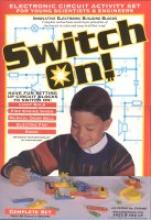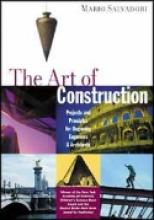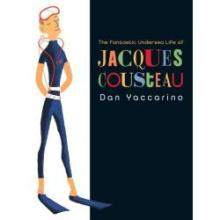Science
Storms
Like Seymour Simon's book on Lightning, reviewed above, this text combines incredible photographs with very interesting text to introduce young readers to some basics of severe weather. The text concentrates on thunderstorms, lightning, hail, tornadoes, and hurricanes. The statistics and little stories about these storms are weird and fascinating and you'll also find lots of solid scientific content.
Sunshine Makes the Seasons
Copyrights 1974/1985
Switch On!
This kit is one of a number of kits aimed at giving children hands on experiments with electronics. It includes a battery holder, 2 capacitors, 2 resistors, 1 pot, 2 bipolar transistors, 2 leds, speaker, mike, motor, a variety of switches, 4 "IC's" and a few other parts.

The unit and connector mechanism is the thing that sets this kit apart from most other kits. The schematic symbol is the predominant feature of most of the elements. This makes the experiment itself look like a schematic diagram. Since I am an electrical engineer this is what convinced me to buy this kit (a little more expensive than it's Radio Shack counterparts). The schematic symbols are usually meaningful icons of what the electronics REALLY are and do.
However, while the idea is fetching the implementation is lacking. Immediately out of the box some connections were hard to make and prone to intermittancy. Simply put, the first circuit we put together did not work until we substituted some parts!! The connectors are like a specialized snap. But the connections aren't always sound; and this can cause an experiment to fail through no fault of the student. This is a fatal flaw. For this reason I don't recommend this kit.
The documentation comes in two parts. One is just pictures of the circuits (schematics but with keyed colors so they are easier to read for little ones). The other offers explanations. The explanations for this kit are very average. Lastly, it seems that most kits fall short when it comes to their "IC's". This, like most kits, treats them as black boxes with no insight into what is happening within them. It is more like magic than science when building circuits with them.
Note: The product is made in China
Switch On! Switch Off!
A very simple children's book designed to explain how electricity works and how it is harnessed to be used in everyday life. The thing my husband (the electrical engineer) liked about this book was that it, quite simply, doesn't have any flaws. It is simple, but substantive.
The Art of Construction
Reading Level: Ages 9-12
The Art of Construction (originally published in 1979 under the title Building: The Fight Against Gravity) is one of the finest examples of books that help children understand principles of science as applied to real life situations - in particular buildings and making sure that they stay up in spite of gravity and natural disasters.
Children are introduced to important concepts like "tension" and "compression" with simple hands on exercises to help understand and remember them. Most chapters include a somewhat-more-involved construction project to teach these principles (and have a lot of fun in the process). Numerous illustrations make concepts and clearer and aid in understanding the building projects.
The text is very engaging and easy-to-understand. We've found it ideal as a read-aloud with a group. Our co-op has been using it somewhere in the 2nd to 4th grade range, although it could certainly used by much older students (all the way through high school would be reasonable). The engineer dads in our co-op have been very impressed with the book and the concepts the children study.
The chapter titles are as follows (and give you a little glimpse of the content and style):
- From Cave to Skyscraper
- Building a Tent
- What is a Beam?
- What do We Build Structures With?
- The Floor of Your Room
- A Steel Frame...Made Out of Paper
- The Part of the Building You Don't See
- What Tornadoes, Earthquakes and Changes in Temperature Can Do
- How to Fight Tornadoes and Earthquakes
- Ropes and Cables
- Sticks and Stones
- Strings and Sticks
- Shape and Strength
- Barrels, Dishes, Butterflies, Bicycles Wheels and Eggs
- Balloons...and Back to the Tent
"If you had one of your friends put your hands on each other's shoulders and move your feet away from each other, you will become a full arch and feel compressed by each other's weight. But if your shoes slip on the floor and you begin to slide apart, the arch will collapse. Its ends must be firmly anchored to prevent it from spreading apart." (pg. 15)
"The best way to understand how the frame of a building works is to build one. A good model of a steel frame can be built with paper, provided we first build the separate elements of the frame: the columns, the beams, and the floors. A column should not take too much floor room, but must be strong enough to carry the compressive loads without buckling under them. A column buckles, that is, bends under compression along its axis, if it is too thin. Take a plastic ruler, stand it up, and push downward on it: there comes a point when the ruler will bend out." (page 39)
"The purpose of a building's structure is to guarantee that the building will stand up under all the loads and forces acting on it: the weights, the pressure of the wind, the forces due to temperature changes, and, possibly, the shaking caused by earthquakes. The builders want to make sure that the building will not collapse, and they hope it will not even be damaged, since in the first case it may kill people and in the second it may be costly to repair. They also want to make sure that the building will not move around. If a house were to slide down the slope of the hill it is built on, or if a skyscraper were to be toppled by the wind, the buildings would have failed their purpose, even if their structures might sometimes ed up undamaged." (page 57)
This is one of the books that I want to be sure each of my children have a chance to study sometime during their school years. Highly recommended!
The Dawkins Delusion?
This would be an ideal resource for the student heading off to a secular college, who may encounter those who will attack his Christian beliefs based on atheistic notions.
The Fantastic Undersea Life of Jacques Cousteau
Like many parents our age, I grew up with Jacques Cousteau, the Frenchman who brought the life below the water level to everyone's homes via TV and films. Here is a colorful, friendly picture book about his life and accomplishments. Curious episodes of his life and his conservation efforts are explained in simple language. Also, beautiful, direct quotes from him are found throughout the colorful book, such as:
If we were logical, the future would be bleak indeed. But we are more than logical. We are human beings, and we faith, and we have hope.
The art is reminiscent of illustrations from the 60s and very pleasant. We read this aloud and some of the facts of his life listed on the last page. We also found plenty on You Tube including longer films of his adventures on his ship, the Calypso.
 Together with another picture book about Jacques Cousteau entitled Manfish by Jennifer Berne, this book can bring alive the life of a great man and his work to any young student .
Together with another picture book about Jacques Cousteau entitled Manfish by Jennifer Berne, this book can bring alive the life of a great man and his work to any young student .
Note: An interesting piece in the NYT about these books on the "red-capped" ocean explorer is worth reading!
The Heart
This is a fascinating and colorful look at the heart and the amazing job it performs. Computer-enhanced photos are used to illustrate the heart and the blood vessels while magnified images give us a close-up look at the blood. Also included are simpler illustrations showing the chambers of the heart, it's valves and arteries and the general make-up of arteries and veins and their valves. The text is simple enough to be understood by fairly young children (particularly as a read-aloud) but is written in such a way as to capture the awe and mystery of how our body works. It covers quite a bit of material in a fairly in-depth fashion - the basic workings and function of the heart, the various components of the blood, the various types and functions of the blood vessels, the basic path of the blood through the body, how the lungs work within the cardiovascular system, the role of white blood cells and some of the problems that people develop in their blood's circulatory system. An impressive, engaging and informative book.
The Insect World of J. Henri Fabre
Jean-Henri Fabre (1823-1915) was a French naturalist who penned many writings about his beloved insects. These essay/stories describe, in great detail, his encounters with some interesting insects – how he worked with them and what he discovered about them. For instance The material is informative and even humorous at times, but rather dense (definitely not dry!). Here is a sample, from "The Pine Processionary"...
You voracious little creatures, if I let you have your way, I should soon be robbed of the murmur of my once so leafy pines! Today I will seek compensation for all the trouble I have taken. Let us make a compact. You have a story to tell. Tell it me; and for a year, for two years or longer, until I know more or less all about it, I shall leave you undisturbed, even at the cost of lamentable suffering to the pines.
Although it might be suitable for high school students and could possibly be read aloud to younger students, it constitutes a portion of the Freshman Lab studies at Thomas Aquinas College. J. Henri Fabre is listed as one of the authors recommended in Catholic Authors: 4-Sight Edition.
A compilation of some of these stories, titled Fabre's Book of Insects is available from Emmanuel Books.
Copyrights 1949/1977








